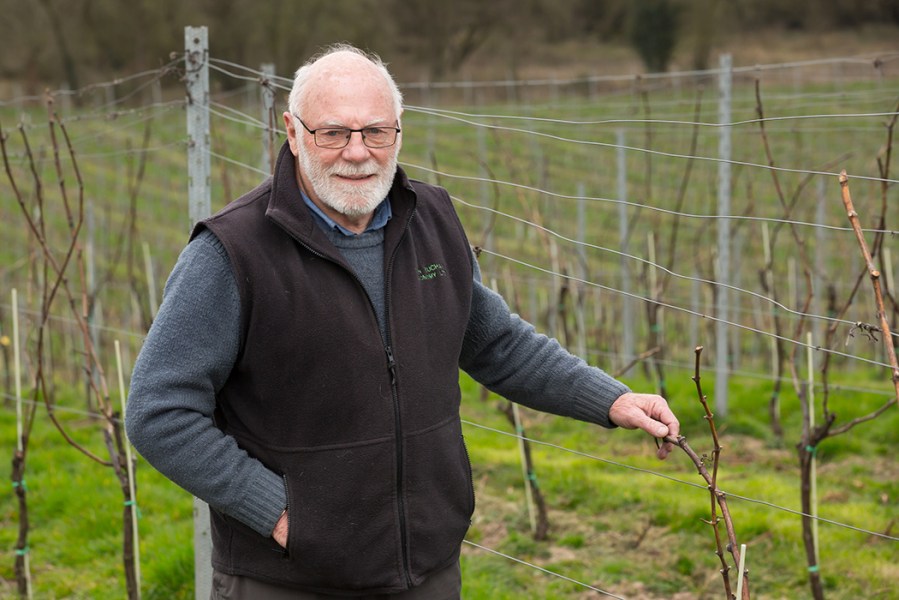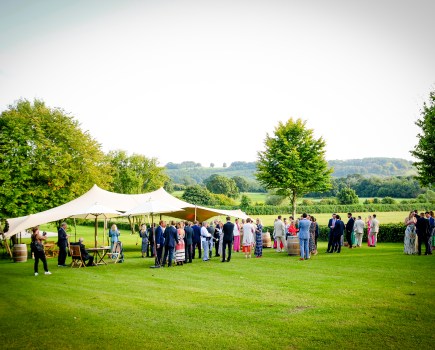Many of the most successful vineyards in the UK have something in common – they have been planned, planted and managed by John Buchan, a Viticultural Agronomist with 20 years’ experience. Vineyard speaks to John to find out how he brings his ‘Midas touch’ to vines.
Although John has 20 years’ experience in viticulture, his agronomy background stretches back many more years and his strong agriculture, farm management and specialist knowledge of plant nutrition probably places John as one of the foremost agronomy experts in UK viticulture today.
John Buchan Agronomy was founded in 2002 and John supplies his clients with a full range of consultancy services – from initial site selection to the creation of full integrated farm management. John has the advantage that he is totally independent of any nutrition, fertiliser, plant protection or other suppliers and so is not limited to the selection of specific products. In fact, with his experience and knowledge, he creates bespoke nutrition and fertiliser combinations for his clients which are formulated for him by selected suppliers. “These are for both conventional and organic vineyards. They are site specific, so that the client can avoid off the shelf formulations – and only needs to apply what is required,” explains John.
John Bucan started his career after studying agriculture and farm management at Brooksby College. After 18 years in farm management, he specialised in plant nutrition with two of the foremost nutritional companies. Those being USA based Stoller Chemicals and the German company Stefus Plant Protection, building up the plant nutrition sector in the UK.
“In 2001, while working as a plant nutritionist, I met Ian A’Court by chance. Ian is now a viticultural consultant, but at the time he was manager of Sharpham Vineyard in Devon. Ian had asked Stoller Chemicals, where I was a plant nutritionist, if anyone knew about vines. My American boss, with his limited knowledge of UK geography decided that Shropshire, where I was based, and Devon were close. So, I visited Sharpham Vineyard to advise on nutrition and that is when my involvement with vineyards started. Shortly after, my next vineyard visit was to Camel Valley in Cornwall and thanks to the owner Bob Lindo – who passed my name around – I ended up really busy.
“After meeting Ian A’Court and Bob Lindo, I realised that vineyard people are really friendly and open, so I decided to focus on viticultural agronomy, specialising in nutrition. I now have over 70 clients – and I will be celebrating 20 years in vineyards in November this year!”
Complete viticulture consultancy
With his unique background in farm management, soils and plant nutrition – and many years specialising in viticulture, John is able to offer a complete consultancy service or tailor made advice depending on his client’s needs. “I can support the client from a vineyards first inception, with a full site assessment, soil analysis with interpretation and recommendations, site improvement and preparation advice, selection of varieties, clones and rootstocks – and the all-important costings. Once the vineyard is planted I provide bespoke, site specific, nutrition and specialist fertilisers, as well as a fully integrated agronomy service. I also guide clients on machinery as there are so many suppliers of specialist vineyard equipment now – it can be a minefield.”
John’s top tips
John always starts the conversation with a new client with a reality check. “Vineyards are romantic, and it’s easy to get seduced into planting one. So, the first thing I ask is what style of wine are you going to make? The second question is who is going to make it? Followed by where and who is going to sell it? Marketing is one of the main issues that is so often ignored.”
A vineyard is likely to have many years in negative cash flow. “Many people are not fully aware of how long this can be – and if they do understand this, many seem to ignore it. Another mistake I often see is people thinking that they can do – and will enjoy doing – a lot of the work in the vineyard themselves. On a fine day it’s lovely to be out in the vines for a few hours, but I remind people to be realistic about what they can actually do. It takes a long time to prune vines, through the cold winter months. Successful vineyard management is about timing – and this is critical as delays in tasks will affect the vines,” John warns.
Purchasing equipment for a vineyard or winery is also time critical. “Planning ahead is key, as lead times on equipment can be many months. So often, people are not aware that these bits of vineyard kit are not available to buy ‘off the shelf’. Sound business planning is also so important for a successful vineyard business, and my advice is to do a plan, stick to it and don’t over-extend.”
Look after your soil
The soil is a significant part of the vines environment and needs to be managed well to ensure it is physically, chemically and biologically sound. “I always emphasise the importance of a good soil management policy. For a start, avoid compaction and panning to preserve soil porosity and ensure aerobic conditions. Without oxygen, in an anaerobic situation, the roots cannot breathe, nor can the beneficial microorganisms. The above ground plant uses CO2 for photosynthesis, but plant roots and soil microorganisms require oxygen – they respire, just as we do.”
Correct soil preparation for planting is so important and often poorly understood, but fortunately John can draw on his farm management experience. “Over the years I have produced seed or planting beds for every type of crop, each has its own requirements, including vines.”
Soil and plant nutrition is John’s speciality, and passion. “I recommended soil analysis every three years and sap or tissue analysis during the season at key growth stages. I find that petiole sap analysis is best for giving a snapshot of the vine’s current nutritional status, and with this information the nutrition can be adjusted to a great extent with foliar feeds, but underlying soil deficiencies cannot be readdressed through the foliar route.”
Vineyard trellising is often left for the second year of growth, mainly to delay the next expenditure, but John sees this as a mistake. “When planting I prefer to get the fruiting wire up in the first year and attach the support tutor or stake to it. This makes sure the young plant is upright, for light interception – and importantly it stops it moving in the wind, which then creates a hole around the base of the vine, allowing for disease.
Thoughts on the future
The wine production industry in the UK has changed dramatically in the 20 year span of John’s viticultural agronomy career, and he has seen it develop rapidly, going from strength to strength. “The main change in the past 20 years has been the rapid increase of plantings, starting from around 1000/ha, to around the 4000/ha now. The obvious acceptance of our climate change has been indicated by the plantings of vines by some of the French Champagne Houses in the south east. I am encouraged to say that there has been an improvement in viticultural practices over the years, through experience and knowledge. In particular there has been an increased acceptance of the importance of knowing your soil with regards to nutritional, biological and physical characteristics. I’m pleased, as this has been my main mission for years, and will continue to be, as we move towards more sustainable methods of soil management.”
The wines produced in England and Wales now receive global recognition and acclaim and John thinks the challenge going forward will be maintaining our status in the world as a premium producer of top-quality wines. “We have blown the myth – so now let’s reap the rewards. I predict that the market will become more and more competitive due to increased production, price pressures and the introduction of Charmat method wines. Although all these factors produce a marketing challenge – in the same way they can open up opportunities.”
When it comes to viticulture, John sees “the advancement of any plant, be it from yield, quality, growth characteristics or disease resistance as a never-ending process. Thus, the continued experimentation in varieties, rootstocks and clones is paramount. We need varieties that will thrive in our climate and produce top quality wines that require lower input costs, thus allowing profitability.”
Wine and classic cars
John enjoys relaxing at the end of the day with a glass of wine from England or Wales. “I could not possibly name names as to which vineyard’s wine I prefer, as there are too many to mention and so many fantastic English and Welsh wines – the wine I choose may depend on which rugby team I am watching.” John’s other passion is classic cars, he has rebuilt many and continues to do so. “I may well turn up to one of your vineyards in one of them,” he warns.




